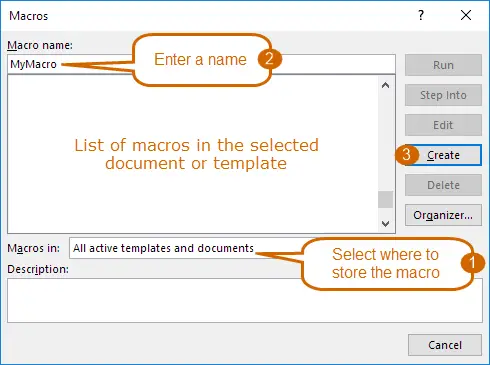What do I do with macros sent to me by other users to help me out?
I don't know how to install them and put them to use
Article contributed by Dave Rado / updated by Lene Fredborg
STEP 1: Open the Macros dialog box
If you are in doubt what Word version you have, see How to find out what version of Word you have.
Word 2007 and later versions – how to open the Macros dialog box
In Word 2007 and later versions macros can only be stored in:
- documents in .docm format
- templates in .dotm format
You can access the macro tools from the Developer tab in the Ribbon. However, the Developer tab is not shown by default. See How to show the Developer tab in the Ribbon for help.
To open the Macros dialog box, select Developer tab >
Macros
or press
Alt+F8.

Go to STEP 2 below.
Word 2000-2003 – how to open the Macros dialog box
To open the Macros dialog box: Select Tools > Macro >
Macros
or press Alt+F8.
Go to STEP 2 below.
STEP 2: Add and edit the macro
In the Macros dialog box, where it says Macros in, select the template or document you want to store the macro in; where it says Macro name, type a name, and click Create.
The Macros in field shows documents and templates that are currently open in Word and global templates.

In the VB editor that opens when you click Create, you will see something like this – any description you entered in the Description field will be shown as part of the green text:
Sub MyMacro()
'
' MyMacro Macro
'
'
End Sub
You can now run the macro. See STEP 3 below.
STEP 3: Run the macro
You can run the macro while you are still in the macro-editing window (normally referred to as the VB Editor or VBE) by pressing F5. You can also size the VBE and the Word window on your screen so you can see them both at once, and step through the macro one line at a time, in order to see what it does, by pressing F8.
To run the macro from within Word, you can press Alt+F8 (or open the Macros dialog box as explained in STEP 1), find the macro in the list, and press Run.
But if you are likely to want to run the macro regularly, you can assign it to a keyboard shortcut, or to a toolbar, or a menu. Or, depending on what name you give your macro, you can assign it to certain events – see:
Intercepting events like Save and Print
Running a macro automatically when Word starts or quits
Running a macro automatically when a document is created, opened or closed
See also Bill Coan's excellent articles Creating a macro with no programming experience using the recorder and Getting To Grips With VBA Basics In 15 Minutes.
Overview of shortcuts
|
Shortcut |
To do this |
Where to use the shortcut |
|
Alt+F8 |
Open the Macros dialog box |
In Word |
|
Alt+F11 |
Open the VB editor |
In Word |
|
F5 |
Run macro |
In the VB editor |
|
F8 |
Step through macro |
In the VB editor |
